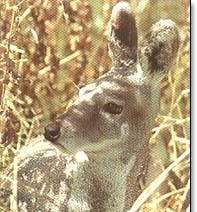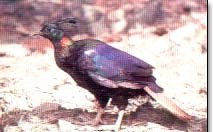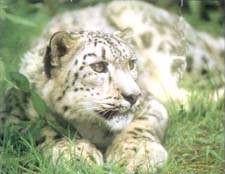India > Wildlife > North Zone
India Wildlife
NORTH ZONE : Uttarakhand, Uttar Pradesh, Jammu Kashmir, Himachal Pradesh, Haryana, Rajasthan
The Corbett National Park, Uttarakhand
It is one of India's premier wildlife reserves. The Hailey National park, as it was then called, was established in 1936 following the advice of the hunter-naturalist Jim Corbett. This wildlife park was categorized as a Project Tiger Reserve in the year 1973. Over 50 mammals, 580 birds and 25 reptile species can be found in this 520 sq km park. The insect life is also intriguing, especially after the monsoons.
Among popular attractions in this area are the leopards, tiger (50 in number) and lesser cats such as the jungle cat and the fishing cat. The sloth bear, Himalayan black bear, dhole, jackal, yellow throated marten, Himalayan palm civet, Indian grey mongoose, common otter, porcupine, clacktaped hare, wild dogs, elephants etc are also found here. The chital, the spotted deer, para, kakkar, and the barking deer are some of the species of deer which can be seen in this area.
The park is a haven for bird watchers. Most of the birds to be found are migrant and generally arrive in the winter season. Some of these are the greylag, barheaded goose, duck, grepe, snipe, sandpiper, gull and wagtail. Permanent residents at the park include pied kingfisher, fishing eagle, darters, cormorants, egrets, herons, the blacknecked stork and the spurwinged lapwings.
One can find reptiles too. They include the gharial, the rare fish eating, long-nosed crocodile, marsh crocodile, the long-snouted gharial and a few species of turtles and tortoises. The Ramganga River has a large population of carp fishes. The Indian python, viper, cobra, krait and king cobra also inhabit the Corbett National Park.
The park is a treasure trove for wildlife - buffs, photographers and anglers. Walking is permitted in some areas, but only when accompanied by a guide. It is therefore advantageous to have one's own vehicle. Elephant rides too, are available, in the mornings and evenings.
How to Reach : The Park is well connected by road to the Dhikala Camp and is connected by railroad to Ramnagar (250 km northeast of Delhi and 63 km southwest of Nainital). A jeep safari is the best way to see animals at close quarters.
Dachigam National Park, Kashmir

Located very close to Srinagar (22 km), Dachigam National Park with its splendid forests and magnificent scenery, is easily accessible. Of all the many sanctuaries in the state. the one at Dachigam is the best known.It was declared a national park in 1951, and owing to a strictly enforced conservation programme, the hangul population, once 150, now stands at over 400 animals.
The two sectors of the Park - Upper and Lower Dachigam are spread over an area of 141 sq km and altitudes vary between 1700 and 4300 m. Two steep ridges enclose the Park with its great topographical variety - deep ravines, rocky outcrops, steep wooded slopes and rolling alpine pastures. Tumbling down from the Masrar lake (4300 m), up in the high ranges, the Dachigam River winds through Lower Dachigam.
The Park is the habitat of the endangered hangul or the Kashmir stag - the only species of red deer to be found in India. Winter is the best time to view the hangul, when they congregate in the shelter of the lower valleys. Other inhabitants include the Himalayan black bear, species of wild goat like the markhor and ibex and varieties of exotic Himalayan birds.
Colourful pheasants include the crimson tragopan, the iridescent monal pheasant with its glittering plumage, the blood pheasant and the koklass pheasant. The golden eagle and the bearded vulture or lammergeier are seen circling the brilliant blue skies. The leopard, which is the only predator in this paradise is rarely seen as also the elusive snow leopard which is found in the higher altitudes. Other animals include the rare musk deer and the Himalayan marmot. A metaled road takes visitors from Srinagar into Lower Dachigam. Upper Dachigam can only be explored on foot.
Amidst forests of silver birch and conifer roams the hangul. Rare and on the verge of extinction till a few years ago, the national park at Dachigam contains the last viable hangul population in the world. Related to the red deer of Europe, this breed is characterised by its white rump patch and impressive spread of antlers.
Best Season : May-Aug (Upper Dachigam), Sept-Dec (Lower Dachigam).
How to Reach : By Air - Srinagar (22 km), Rail - Jammu (200 km).
Gulmarg Biosphere Reserve, Kashmir
Gulmarg Biosphere Reserve 48 km from Srinagar, the reserve has an area of 180 sq km, and an altitudinal range of 2,400 - 4,300 m. Fauna includes Himalayan musk deer, red fox, brown and black bear. Among avi fauna are upland birds, both resident and migratory.
Best time to visit : for animal September - March
bird viewing March - May.
Nandini Wildlife Sanctuary
Nandni Wildlife Sanctuary (26 km) the sanctuary has an area of 33 sq km.
Overa-Aru Biosphere Reserve, Kashmir

Overa-Aru Biosphere Reserve located 76 km from Srinagar, near Pahalgam, it has an area of 32 sq km. Several species of birds as well as fauna are found here - musk deer, brown bear, leopard to name a few. The altitudinal range varies from 3,000 to 5,425 m above sea level. Prime viewing time for the upper areas is from May to August In the lower areas, for bird viewing the best time is March to May and for animal viewing from September to March. Accommodation in two bedroom huts is available. For passes contact the Regional wildlife Warden, Srinagar.
Overs Wildlife Sanctuary, Kashmir
Overa wildlife Sanctuary located 76 km from Srinagar, near Pahalgam, it has an area of 32 sq km, and is famed for its many species of pheasants. It sustains 13 species of mammals and over 80 species of birds. The best time to visit the sanctuary and For overnight stay there is a two bedroom hut as well as a 10 bedded dormitory. For passes and reservations, contact the office of the Chief wildlife Warden, Tourist Reception Centre, Srinagar.
Best time to visit : for mammal viewing is September to April.
for bird viewing March to August.
Ramnagar Wildlife Sanctuary, Jammu
Ramnagar Wildlife Sanctuary situated only 6 km away from, Jammu city, this sanctuary occupies an area of 31 km. The area sustains 8 mammal species including Nilgai and barking deer, and 15 species of birds. Within the sanctuary is a two bedroom hut. For passes contact the Regional Wildlife Warden, Jammu (near Jammu Ashok hotel).
Best time to visit : for mammal viewing is September-May
for bird viewing, March to May.
Surinsar Mansar Wildlife Sanctuary, Jammu
Surinsar Mansar wildlife Sanctuary named for the two lakes on each comer of it this sanctuary comprises an area of 98 sq km, and supports a mammal population of 8 species, and up to 15 species of birds.
The Hemis High Altitude National Park, Ladakh Kashmir

The Hemis High Altitude National Park includes the catchments of two valleys which drain into the River Indus. It is named after the famous monastery - Hemis, and sprawls over 600 sq km. Approachable by road from Leh, this national park contains several camping sites. The area is barren and rocky, covered only sparsely with vegetation. Most of the ten species of mammal here are extremely rare - shapu, bharal, great Tibetan sheep, ibex and snow leopard. The avifauna too comprises species which are not seen at lower altitudes : Himalayan snow cock being an example. The best season for mammal viewing is September to May and for bird viewing March to May and September to December. For passes contact the Wildlife warden, Leh.
The Great Himalayan National Park, Himachal
The largest protected area in Himachal Pradesh, the Park is carved out of the splendid mountain terrain of the Kullu district. Rich coniferous forests, alpine meadows carpeted with flowers, snow-capped peaks and glaciers provide a breathtaking panorama. The secluded Sainj and Tirthan valleys harbour a variety of animals common to this area - wild mountain goats like the bharal, goral and serow, the brown bear and predators like the leopard and the rarely seen snow leopard. Varieties of colourful pheasants - monal, khalij cheer, tragopan and other Himalayan birds are part of its rich avian population. Trekking through the Park to Rakte Sar, the origin of the Sainj River, brings in the added pleasure of seeing wildlife in this spectacular natural environment.
Sariska Wildlife Sanctuary, Rajasthan
This wildlife park came into existence in the year 1955 and was given the status of a Sariska Wildlife Sanctuary National Park in the year 1979. Prior to the year 1955 Sariska was the game hunting reserve of the Maharaja of Alwar, Rajasthan.
Sariska is located in the midst of the Aravallis that are covered with deciduous dry forests. A Jeep safari with the permission of the Forest officials will be the best way to see animals closely. The historical sites nearby are the ruins of the Neelkanth temples, Garh-Rajor temples, Kankwari Fort and the Sariska Palace (heritage hotel).
Wildlife : Leopard, Hyena, Wild Dog, Jackal, Jungle Cat, Bengal Fox, Common Palm Civet, Indian Hare, Ratel, Indian Grey Mongoose, Northern Palm Squirrel, Tiger, Sambar, Chausingha, Nilgai, Chital, Wild Boar, Langurs and Rhesus Monkeys.
Common birds are the Peafowl, Sand Grouse, Grey Partridge, Tree Pie, Bush Quail, Golden backed Wood Pecker, Great Indian Horned Owl and the Crested Serpent Eagle.
Best Season : October to June.
How to Reach : The Sanctuary is 37 km from Alwar.
Tal Chhapar Sanctuary, Rajasthan
It is a bird watchers paradise and is known for the black-buck that is a flat saline depression with its own ecosystem. A number of migratory birds - marsh harrier, ben harrier and the pale harrier - visit this region during September. Other birds found are imperial eagle, sparrow hawk, crested lark, skylark, brown dove, black ibis, green bee-eaters, blue jays and cranes.
How to Reach : 220 km from Jaipur in Churu district.
Ranthambore National Park, Rajasthan
It is one of the largest Tiger Reserves in India. This forest was declared as a wildlife park in the year 1955 and was later given the status of a National Park in the year 1984, after the Project Tiger was launched. The Ranthambore forests have plenty of mango, peepal and banyan trees (some are 700 years old).
Wildlife : tigers (30 in number), jungle cat, hyena, langur, spotted deer, crocodile, sloth bear, sambhar (largest Asiatic deer), nilgai, caracal and leopards.
Common birds are the Great Indian horned owl, peacock, spoonbills, partridge, parakeets, quail, kingfishers, owls, storks, ducks and geese.
How to Reach : The Sanctuary is 145 km from Jaipur, and the nearest railway station is Sawai Madhopur, 14 km away.
Bharatpur Bird Sanctuary, Rajasthan
The Sanctuary is popularly known as Keoladeo Ghana National Park. Keoladeo is basically the name of an ancient temple that is located at the center of the Bharatpur bird sanctuary.
In the year 1760 the Ajan Dam was constructed to save the town of Bharatpur from annual floods and the depression that came into existence after extraction of soil for building the dam turned into the Bharatpur Lake. This area was developed to serve as a duck shooting wildlife preserve for the royalty of Bharatpur. This area was declared to be a national park in the year 1982.
The 40 sq km swampy Bharatpur bird sanctuary is home to more than 300 species of birds. The birds found are pelicans, cranes, flycatchers, buntings, larks, pipits, wagtails, stints, eagles, hawks geese, shanks, ducks, Siberian Cranes and warblers. The animals of the park are boar, Chital, Nilgai and Sambar.
There are quite a few well-known forest trails at the Bharatpur bird sanctuary that can be traversed on foot or on cycles. Boat rides on the lakes can prove to be the most interesting and exciting bird watching experience of your life.
How to Reach : 57 km from Agra, on Delhi-Jaipur highway
Best Season : October to January.
Sultanpur National Park, Haryana
The 359 acre wildlife park has been developed around the Sultanpur Lake. The area was declared as a bird sanctuary in the year 1971 and got the status of a national park in the year1981. The vegetation at the Sultanpur National park is mostly tropical and dry deciduous. The park is full of trees such as dhok, tendu, khair, jamun, ber, acacia and banyan tree.
The birds found are Migratory geese, Siberian cranes, demoiselle cranes, flamingoes, ruddy shelducks, pelicans, gadwalls, grey lags, mallards, shovellers, pochards, teals, plovers, spoonbills, red-wattled lapwings, cormorants, herons and painted storks.
The animals found in the park are blackbuck, hog deer, nilgai, wild dog, sambar, caracal, hedgehog, striped hyena, honey badgers, Indian porcupine, leopards, four horned antelope and wild pigs.
How To Reach : This wildlife sanctuary lies on the Gurgaon-Farukh Nagar Road, about 15 km from Sultanpur.
Best Season : winter months

